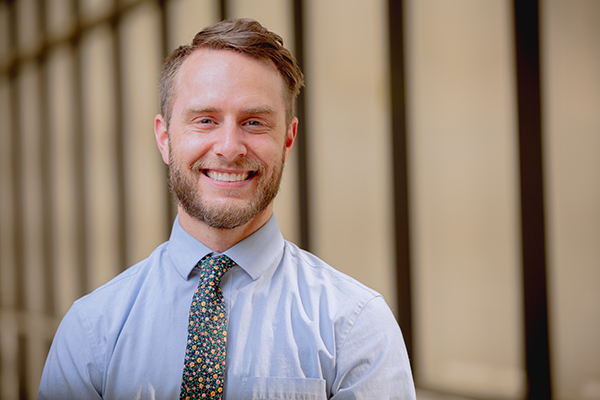 Above: Dr. Kevin Schwalbach, Chief Medical Resident (2020-2021)
Above: Dr. Kevin Schwalbach, Chief Medical Resident (2020-2021)
After Kevin Schwalbach, M.D., received his Bachelor of Science from DePaul University in Minnesota, he was unsure of where his love for science would lead him. He spent the next four years in basic science, studying the development of zebrafish and stickleback fish. Though he enjoyed four years in basic research, it became clear to Schwalbach that all roads led to medicine.
So Schwalbach enrolled in the University of Minnesota Medical School. When it was time to consider where he would complete residency after graduation, he and his wife applied to roughly 100 programs.
“UAB is the hospital in Alabama.” He continues, “You get such a diversity of patient population and pathology. You can see so much, which is great.”
Not only would his training lead him to experience a tremendous breadth of patient care, the program also enabled him to dive headfirst into clinical research. A conversation with Joseph Barney, M.D., professor in the division of Pulmonary, Allergy, and Critical Care, inspired Schwalbach to investigate the effectiveness of intraosseous (IO) resuscitation in patients during in-hospital cardiac arrest.
Barney observed that physicians use IO (a method in which medication is administered to a patient by drilling into the bone), without substantial evidence that the method is as effective as peripheral intravenous (PIV) resuscitation. He hypothesized that IO may have different outcomes than the standard PIV, and particularly that it would improve outcomes in those patients with obesity.
Schwalbach led a retrospective study where he worked with UAB colleagues—a faculty member, a pulmonary fellow, and another resident—to test the hypothesis. They analyzed 3,000 patient charts. The team found that there were no significant differences in survival, neurological outcomes, or the return of spontaneous circulation. The information found would permit an active randomized study that further investigates PIV and IO resuscitation. Their findings were published in the journal Resuscitation.
During the pandemic in 2020-2021, he transitioned to his chief medical residency (CMR) year in medicine and research. As a Clinical CMR, he was responsible for attending, administrative duties, and leading lectures for residents. He also assisted leaders with creating innovative lessons to provide residents with the same volume of exposure they would have pre-COVID. As a Research CMR, Schwalbach paired residents with mentors, helped them select and present research projects, and aided in the construction of a lecture series.
Despite many challenges, the pandemic helped Schwalbach identify his passion for pulmonary vascular research and critical care. He is currently working as a hospitalist at UAB and preparing to apply for fellowship programs in pulmonary and critical care.
“If at the end of my medical career, I have been able to help just a small group of people, whether it be patients or the next generations of physicians, I would be able to say I was successful,” Schwalbach concludes.
UAB’s unique training environment convinced a Minnesota native to come to Birmingham, exposed him to diverse patient populations and treatment, fostered his investigative skills and taught him how to overcome unforeseen challenges, preparing him for a bright future in academic medicine.